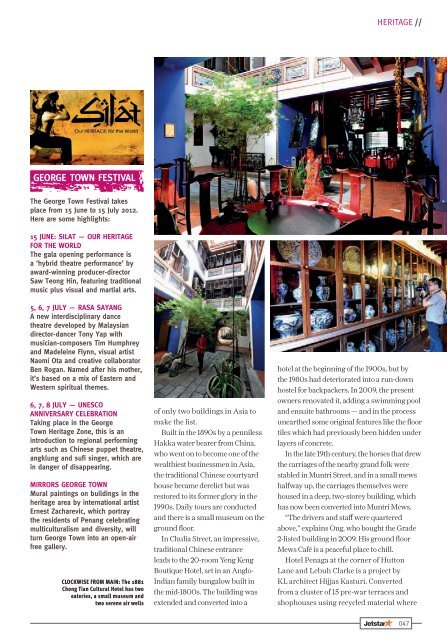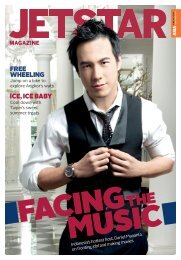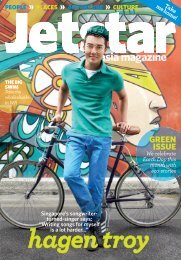Create successful ePaper yourself
Turn your PDF publications into a flip-book with our unique Google optimized e-Paper software.
GEORGE TOWN FESTIVAL<br />
The George Town Festival takes<br />
place from 15 June to 15 July <strong>2012</strong>.<br />
Here are some highlights:<br />
15 JUNE: SILAT — OUR HERITAGE<br />
FOR THE WORLD<br />
The gala opening performance is<br />
a ‘hybrid theatre performance’ by<br />
award-winning producer-director<br />
Saw Teong Hin, featuring traditional<br />
music plus visual and martial arts.<br />
5, 6, 7 JULY — RASA SAYANG<br />
A new interdisciplinary dance<br />
theatre developed by Malaysian<br />
director-dancer Tony Yap with<br />
musician-composers Tim Humphrey<br />
and Madeleine Flynn, visual artist<br />
Naomi Ota and creative collaborator<br />
Ben Rogan. Named after his mother,<br />
it’s based on a mix of Eastern and<br />
Western spiritual themes.<br />
6, 7, 8 JULY — UNESCO<br />
ANNIVERSARY CELEBRATION<br />
Taking place in the George<br />
Town Heritage Zone, this is an<br />
introduction to regional performing<br />
arts such as Chinese puppet theatre,<br />
angklung and sufi singer, which are<br />
in danger of disappearing.<br />
MIRRORS GEORGE TOWN<br />
Mural paintings on buildings in the<br />
heritage area by international artist<br />
Ernest Zacharevic, which portray<br />
the residents of Penang celebrating<br />
multiculturalism and diversity, will<br />
turn George Town into an open-air<br />
free gallery.<br />
CLOCKWISE FROM MAIN: The 1881<br />
Chong Tian Cultural Hotel has two<br />
eateries, a small museum and<br />
two serene air wells<br />
of only two buildings in Asia to<br />
make the list.<br />
Built in the 1890s by a penniless<br />
Hakka water bearer from China,<br />
who went on to become one of the<br />
wealthiest businessmen in Asia,<br />
the traditional Chinese courtyard<br />
house became derelict but was<br />
restored to its former glory in the<br />
1990s. Daily tours are conducted<br />
and there is a small museum on the<br />
ground fl oor.<br />
In Chulia Street, an impressive,<br />
traditional Chinese entrance<br />
leads to the 20-room Yeng Keng<br />
Boutique Hotel, set in an Anglo-<br />
Indian family bungalow built in<br />
the mid-1800s. The building was<br />
extended and converted into a<br />
HERITAGE //<br />
hotel at the beginning of the 1900s, but by<br />
the 1980s had deteriorated into a run-down<br />
hostel for backpackers. In 2009, the present<br />
owners renovated it, adding a swimming pool<br />
and ensuite bathrooms — and in the process<br />
unearthed some original features like the fl oor<br />
tiles which had previously been hidden under<br />
layers of concrete.<br />
In the late 19th century, the horses that drew<br />
the carriages of the nearby grand folk were<br />
stabled in Muntri Street, and in a small mews<br />
halfway up, the carriages themselves were<br />
housed in a deep, two-storey building, which<br />
has now been converted into Muntri Mews.<br />
“The drivers and staff were quartered<br />
above,” explains Ong, who bought the Grade<br />
2-listed building in 2009. His ground fl oor<br />
Mews Café is a peaceful place to chill.<br />
Hotel Penaga at the corner of Hutton<br />
Lane and Lebuh Clarke is a project by<br />
KL architect Hijjas Kasturi. Converted<br />
from a cluster of 15 pre-war terraces and<br />
shophouses using recycled material where<br />
047
















